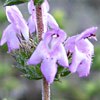Satureja thymbra (Savory of Crete) is an erect, fragrant, dwarf-shrub. It is very branched and dense and reaches a height of 30-45 cm. The leaves are ovate, leathery, their base is cuneate and their head is acuminate. They have a unique sign: the leaves are folded along the midvein. The winter leaves are broader than the summer leaves. The leaves and stems are covered with glands that secrete a pungent fluid, which is used as a spice. They are also covered with erect hairs.
Savory of Crete blooms during the entire spring and summer, from March to September. The flowers are arranged in dense whorls that extend from the axils. The flower is typical of the Lamiaceae. It is light purple. There are dark purple spots in the center of the middle lobe of the lower lip (and not in the throat of the corolla!). The anthers of the 4 stamens are conspicuous in dark purple on a background of the light upper lip of the corolla. The throat of the corolla is pilose, covered with long hairs. The margins of the corolla lobes are pilose covered with very short hairs. The flower is pollinated by bees.
Savory of Crete grows in Bathas and Garigues on the Mediterranean Mountains. It dominates especially on chalk rocks, and also grows out of chalky soil and from cracks in limestone rocks. Its global distribution is in the countries surrounding the Mediterranean, mainly to its east.
The genus includes 30 species (some claim 200). In Israel there are 3 species. Another species is cultivated as a spice.
Savory of Crete has many uses both as a spice and as a folk medicine for ailments of the respiratory tract, the digestive tract and the skin. It is also used against dizziness, for calming the nerves, etc.
Written by Mike Livne








